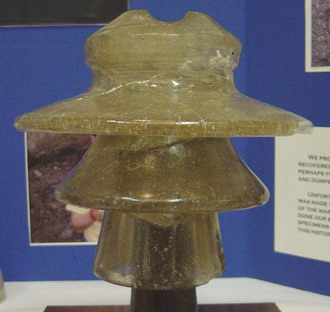
Fred Locke's Attic (page 5)

Around 1909-10, Fred Locke had various insulators made based on his early glass patents. He called this glass "transparent porcelain" and "boro-porcelain" because he made the discovery by adding large amounts of boron compounds in order to improve the characteristics of porcelain. The glass is muddy looking and full of bubbles and bits of chemicals that did not melt and mix with the other ingredients. These insulators were made for him by Brookfield. The 3-part insulator shown above is identical to the Brookfield No. 331 (CD 365).
Around 1912 he started having insulators made at Corning Glass Works based on his next generation of glass patents. This glass was very similar to Pyrex glass, which Corning had under development and patented a few years later. Corning abruptly stopped making insulators for Fred Locke 1916. This forced Fred Locke to cancel an order for suspension insulators he was making for shipment to Italy. A law suit followed, which Corning settled by paying off Fred Locke. This was so they could get clear rights to their Pyrex patent. Insulators made at Corning using Fred Locke's patents can range in color from clear to light lemon, to pale aqua. In 1916, he filed for a patent (granted in 1922) for a glass produced by mixing in various opacifying metals. These insulators made from these glass formulas would be white opalescent and black. Jeff and Ken found such insulators in the "attic" dig.
Black glass suspension disk.
The insulator on the left (and shown below) is similar to CD 286 on the right. It is unmarked and made by Brookfield for Fred Locke.
Another odd glass insulator.
Blue glazed porcelain disc??
There will be more reports to follow as Jeff and Ken make new discoveries. May have to wait for the Spring thaw. I will also be working on drawing up all the new U-number styles from the dig. Here are a few more photos to enjoy.